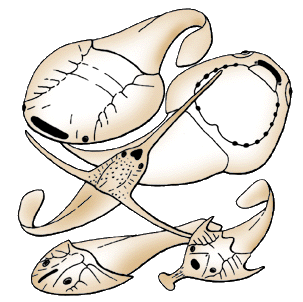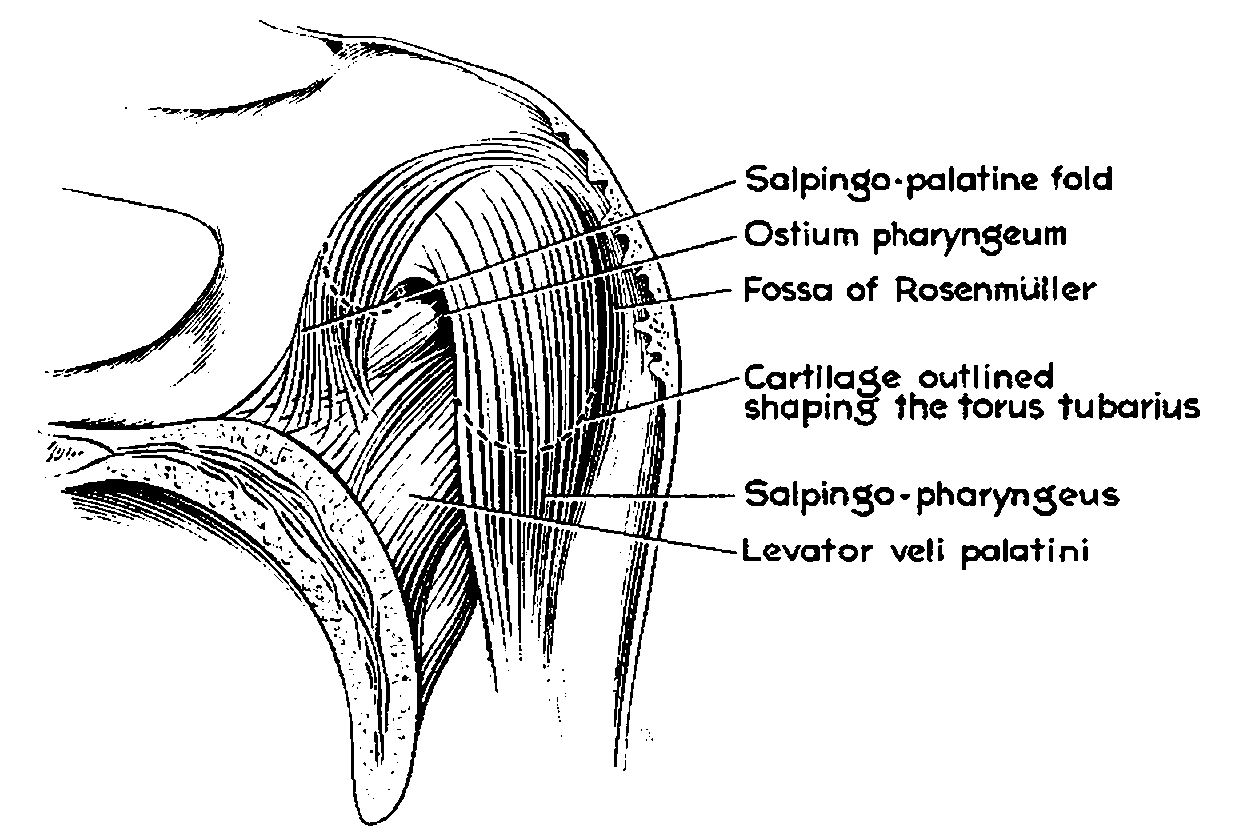|
Galeaspida
Galeaspida (from Latin, 'Helmet shields') is an extinct taxon of jawless marine and freshwater fish. The name is derived from ''galea'', the Latin word for ''helmet'', and refers to their massive bone shield on the head. Galeaspida lived in shallow, fresh water and marine environments during the Silurian and Devonian times (430 to 370 million years ago) in what is now Southern China, Tibet and Vietnam. Superficially, their morphology appears more similar to that of Heterostraci than Osteostraci, there being currently no evidence that the galeaspids had paired fins. A galeaspid ''Tujiaaspis vividus'' from the Silurian period of China was described in 2022 as having a precursor condition to the form of paired fins seen in Osteostraci and gnathostomes. Earlier than this, Galeaspida were already in fact regarded as being more closely related to Osteostraci, based on the closer similarity of the morphology of the braincase. Morphology The defining characteristic of all galeaspids w ... [...More Info...] [...Related Items...] OR: [Wikipedia] [Google] [Baidu] |
Galeaspida
Galeaspida (from Latin, 'Helmet shields') is an extinct taxon of jawless marine and freshwater fish. The name is derived from ''galea'', the Latin word for ''helmet'', and refers to their massive bone shield on the head. Galeaspida lived in shallow, fresh water and marine environments during the Silurian and Devonian times (430 to 370 million years ago) in what is now Southern China, Tibet and Vietnam. Superficially, their morphology appears more similar to that of Heterostraci than Osteostraci, there being currently no evidence that the galeaspids had paired fins. A galeaspid ''Tujiaaspis vividus'' from the Silurian period of China was described in 2022 as having a precursor condition to the form of paired fins seen in Osteostraci and gnathostomes. Earlier than this, Galeaspida were already in fact regarded as being more closely related to Osteostraci, based on the closer similarity of the morphology of the braincase. Morphology The defining characteristic of all galeaspids w ... [...More Info...] [...Related Items...] OR: [Wikipedia] [Google] [Baidu] |
Vertebrates
Vertebrates () comprise all animal taxa within the subphylum Vertebrata () ( chordates with backbones), including all mammals, birds, reptiles, amphibians, and fish. Vertebrates represent the overwhelming majority of the phylum Chordata, with currently about 69,963 species described. Vertebrates comprise such groups as the following: * jawless fish, which include hagfish and lampreys * jawed vertebrates, which include: ** cartilaginous fish (sharks, rays, and ratfish) ** bony vertebrates, which include: *** ray-fins (the majority of living bony fish) *** lobe-fins, which include: **** coelacanths and lungfish **** tetrapods (limbed vertebrates) Extant vertebrates range in size from the frog species '' Paedophryne amauensis'', at as little as , to the blue whale, at up to . Vertebrates make up less than five percent of all described animal species; the rest are invertebrates, which lack vertebral columns. The vertebrates traditionally include the hagfish, wh ... [...More Info...] [...Related Items...] OR: [Wikipedia] [Google] [Baidu] |
Fish
Fish are aquatic, craniate, gill-bearing animals that lack limbs with digits. Included in this definition are the living hagfish, lampreys, and cartilaginous and bony fish as well as various extinct related groups. Approximately 95% of living fish species are ray-finned fish, belonging to the class Actinopterygii, with around 99% of those being teleosts. The earliest organisms that can be classified as fish were soft-bodied chordates that first appeared during the Cambrian period. Although they lacked a true spine, they possessed notochords which allowed them to be more agile than their invertebrate counterparts. Fish would continue to evolve through the Paleozoic era, diversifying into a wide variety of forms. Many fish of the Paleozoic developed external armor that protected them from predators. The first fish with jaws appeared in the Silurian period, after which many (such as sharks) became formidable marine predators rather than just the prey of arthrop ... [...More Info...] [...Related Items...] OR: [Wikipedia] [Google] [Baidu] |
Eugaleaspidiformes
Eugaleaspidiformes (from Latin, "Helmet shield shapes") is an extinct order of jawless marine and freshwater fish, which lived in East Asia from the Telychian to the Lower Devonian period. The order was first named by Lui in 1965. Examples *''Nochelaspis'' *''Shuyu'' * Falxcornus *Dunyu * Xitunaspis *Yongdongaspis ''Yongdongaspis'', colloquially known as the Binhai Yongdong, is an extinct genus of galeaspid within the monotypic family Yongdongaspididae. The type species is ''Y. littoralis'' and it was found in the Silurian-aged Huixingshao Formation of Ch ... *'' Qingshuiaspis'' *'' Anjiaspis'' References Galeaspida Early Devonian extinctions Prehistoric fish orders {{paleo-jawless-fish-stub ... [...More Info...] [...Related Items...] OR: [Wikipedia] [Google] [Baidu] |
Heterostraci
Heterostraci ( Ancient Greek, ἕτερος+ὄστρακον "those itha different shell" i is pl. of -us is an extinct subclass of pteraspidomorph jawless vertebrate that lived primarily in marine and estuary environments. Heterostraci existed from the mid- Ordovician to the conclusion of the Devonian. Description and anatomy The Heterostracans differed from other Paleozoic agnathan taxa both in the arrangement and histology of their scales. Most heterostracans had two plates which form a large dorsal shield and a large ventral shield, and had series of scales arranged in various patterns on the sides of their bodies, the exact pattern differing from one group to another. In a few primitive forms, such as ''Lepidaspis'', the dorsal and ventral shields are composed of a mosaic of tiny scales. In most other known forms, though, these tiny scales have fused together to form the shield-plates. The scales of heterostracans are histologically distinct from other vertebrate ... [...More Info...] [...Related Items...] OR: [Wikipedia] [Google] [Baidu] |
Olfaction
The sense of smell, or olfaction, is the special sense through which smells (or odors) are perceived. The sense of smell has many functions, including detecting desirable foods, hazards, and pheromones, and plays a role in taste. In humans, it occurs when an odor binds to a receptor within the nasal cavity, transmitting a signal through the olfactory system. Glomeruli aggregate signals from these receptors and transmit them to the olfactory bulb, where the sensory input will start to interact with parts of the brain responsible for smell identification, memory, and emotion. There are many different causes for alteration, lack, or disturbance to a normal sense of smell, and can include damage to the nose or smell receptors, or central problems affecting the brain. Some causes include upper respiratory infections, traumatic brain injury, and neurodegenerative disease. History of study Early scientific study of the sense of smell includes the extensive doctoral dis ... [...More Info...] [...Related Items...] OR: [Wikipedia] [Google] [Baidu] |
Dorsum (biology)
Standard anatomical terms of location are used to unambiguously describe the anatomy of animals, including humans. The terms, typically derived from Latin or Greek roots, describe something in its standard anatomical position. This position provides a definition of what is at the front ("anterior"), behind ("posterior") and so on. As part of defining and describing terms, the body is described through the use of anatomical planes and anatomical axes. The meaning of terms that are used can change depending on whether an organism is bipedal or quadrupedal. Additionally, for some animals such as invertebrates, some terms may not have any meaning at all; for example, an animal that is radially symmetrical will have no anterior surface, but can still have a description that a part is close to the middle ("proximal") or further from the middle ("distal"). International organisations have determined vocabularies that are often used as standard vocabularies for subdisciplines of an ... [...More Info...] [...Related Items...] OR: [Wikipedia] [Google] [Baidu] |
Pharynx
The pharynx (plural: pharynges) is the part of the throat behind the mouth and nasal cavity, and above the oesophagus and trachea (the tubes going down to the stomach and the lungs). It is found in vertebrates and invertebrates, though its structure varies across species. The pharynx carries food and air to the esophagus and larynx respectively. The flap of cartilage called the epiglottis stops food from entering the larynx. In humans, the pharynx is part of the digestive system and the conducting zone of the respiratory system. (The conducting zone—which also includes the nostrils of the nose, the larynx, trachea, bronchi, and bronchioles—filters, warms and moistens air and conducts it into the lungs). The human pharynx is conventionally divided into three sections: the nasopharynx, oropharynx, and laryngopharynx. It is also important in vocalization. In humans, two sets of pharyngeal muscles form the pharynx and determine the shape of its lumen. They are ... [...More Info...] [...Related Items...] OR: [Wikipedia] [Google] [Baidu] |
Gill Chamber
A gill () is a respiratory organ that many aquatic organisms use to extract dissolved oxygen from water and to excrete carbon dioxide. The gills of some species, such as hermit crabs, have adapted to allow respiration on land provided they are kept moist. The microscopic structure of a gill presents a large surface area to the external environment. Branchia (pl. branchiae) is the zoologists' name for gills (from Ancient Greek ). With the exception of some aquatic insects, the filaments and lamellae (folds) contain blood or coelomic fluid, from which gases are exchanged through the thin walls. The blood carries oxygen to other parts of the body. Carbon dioxide passes from the blood through the thin gill tissue into the water. Gills or gill-like organs, located in different parts of the body, are found in various groups of aquatic animals, including mollusks, crustaceans, insects, fish, and amphibians. Semiterrestrial marine animals such as crabs and mudskippers have gill cha ... [...More Info...] [...Related Items...] OR: [Wikipedia] [Google] [Baidu] |
Hagfish
Hagfish, of the class Myxini (also known as Hyperotreti) and order Myxiniformes , are eel-shaped, slime-producing marine fish (occasionally called slime eels). They are the only known living animals that have a skull but no vertebral column, although hagfish do have rudimentary vertebrae. Along with lampreys, hagfish are jawless; the two form the sister group to jawed vertebrates, and living hagfish remain similar to hagfish from around 300 million years ago. The classification of hagfish had been controversial. The issue was whether the hagfish was a degenerate type of vertebrate-fish that through evolution had lost its vertebrae (the original scheme) and was most closely related to lampreys, or whether hagfish represent a stage that precedes the evolution of the vertebral column (the alternative scheme) as is the case with lancelets. Recent DNA evidence has supported the original scheme. The original scheme groups hagfish and lampreys together as cyclostomes (or histori ... [...More Info...] [...Related Items...] OR: [Wikipedia] [Google] [Baidu] |
Nasopharyngeal
The pharynx (plural: pharynges) is the part of the throat behind the mouth and nasal cavity, and above the oesophagus and trachea (the tubes going down to the stomach and the lungs). It is found in vertebrates and invertebrates, though its structure varies across species. The pharynx carries food and air to the esophagus and larynx respectively. The flap of cartilage called the epiglottis stops food from entering the larynx. In humans, the pharynx is part of the digestive system and the conducting zone of the respiratory system. (The conducting zone—which also includes the nostrils of the nose, the larynx, trachea, bronchi, and bronchioles—filters, warms and moistens air and conducts it into the lungs). The human pharynx is conventionally divided into three sections: the nasopharynx, oropharynx, and laryngopharynx. It is also important in vocalization. In humans, two sets of pharyngeal muscles form the pharynx and determine the shape of its lumen. They are arranged as an in ... [...More Info...] [...Related Items...] OR: [Wikipedia] [Google] [Baidu] |








